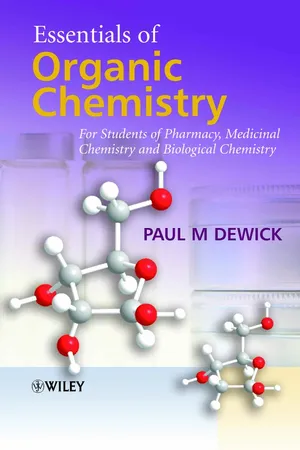Chemistry
Amino Acids
Amino acids are organic compounds that serve as the building blocks of proteins. They contain an amine group, a carboxylic acid group, and a side chain that varies among different amino acids. There are 20 standard amino acids that are commonly found in proteins, each with its own unique chemical structure and properties.
Written by Perlego with AI-assistance
Related key terms
6 Key excerpts on "Amino Acids"
- eBook - ePub
- Andreas Manz, Petra S Dittrich, Nicole Pamme, Dimitri Iossifidis(Authors)
- 2015(Publication Date)
- ICP(Publisher)
Chapter 1BIOMOLECULES
In this chapter you will learn about ...... the biomolecules that are most relevant for bioanalytical chemistry: Amino Acids, proteins, nucleic acids, lipids and oligosaccharides.... the structure of these biomolecules and their physical and chemical characteristics.... some of the functions of these biomolecules and how they interact with each other in the cell.... what systems biology is.Chemistry students are likely to be familiar with certain biomolecules such as carbohydrates and lipids from their organic chemistry lectures. However, many students do not have a clear understanding of the composition and function of other biomolecules such as proteins and DNA. Therefore, this chapter introduces the biomolecules, which are the target of the analytical methods described in the following ch apters.1.1Amino Acids, Peptides and Proteins
Amino Acids are the building blocks for peptides and proteins and play an important part in metabolism. About 20 different Amino Acids are found in living organisms. They can connect to each other via peptide bonds to form long chains. Proteins may consist of thousands of Amino Acids and can have molecular weights of up to several million Dalton (Da). Shorter chains of up to a few hundred Amino Acids are referred to as peptides. The sequence of the Amino Acids within the molecule is essential for the structure and function of proteins and peptides in biological processes.1.1.1Amino AcidsThe general structure of an amino acid is shown in Fig. 1.1 . It consists of a tetrahedral carbon atom (C-alpha) connected to four groups: a basic amino group (–NH2 ), an acidic carboxyl group (–COOH), a proton (–H) and a substituent group (–R), which varies from one amino acid to another. The amino group is in the alpha position relative to the carboxyl group, hence the name α - eBook - ePub
- Guoyao Wu(Author)
- 2017(Publication Date)
- CRC Press(Publisher)
4 Chemistry of Protein and Amino AcidsThe word “protein” originated from the Greek word “proteios ,” meaning prime or primary (Meister 1965). A protein is a large polymer of Amino Acids (AAs) linked via the peptide bond (–CO–NH–). Different proteins have different chemical properties (e.g., AA sequences, molecular weights, ionic charges, three-dimensional (3D) structures, hydrophobicity, and function). The general structure of an AA is shown in Figure 4.1 . There may be one or more polypeptide chains in a protein, which contains its constituents (nitrogen, carbon, oxygen, hydrogen, and sulfur atoms). A protein may be covalently bonded to other atoms and molecules (e.g., phosphates) and non-covalently attached with minerals (e.g., calcium, iron, copper, zinc, magnesium, and manganese), certain vitamins (e.g., vitamin B6 , vitamin B12 , and lipid-soluble vitamins), and/or lipids. Protein is the major nitrogenous macronutrient in foods and the fundamental component of animal tissues (Wu 2016). It has structural, signaling, and physiological functions in animals (Table 4.1 ).Figure 4.1 Fisher projections for configurations of AAs relative to l - and d -glyceraldehydes. The general structure of an AA in the non-ionized form is shown. For AAs, l - or d -isomers refer only to the chemical configuration of their α - eBook - ePub
Equine Applied and Clinical Nutrition
Health, Welfare and Performance
- Raymond J. Geor, Manfred Coenen, Pat Harris(Authors)
- 2013(Publication Date)
- Saunders(Publisher)
Areas where additional research is warranted are identified throughout the chapter. Basic properties of proteins and Amino Acids Chemical structure and classification The general structure common to all Amino Acids is shown in Fig. 6.1. Each amino acid consists of an α-carbon that is attached to an amino group, a carboxylic acid group and a side chain group, which is unique to each amino acid. There are 21 different Amino Acids that are a part of mammalian proteins (Fig. 6.2), and these Amino Acids can be classified based on the chemical properties of the side chain group and on the basis of dietary essentiality. Figure 6.1 Basic structure of all α-Amino Acids. Figure 6.2 Structure and classification of the α-Amino Acids found in mammalian proteins. Although histidine is not shown with the additional proton and positive charge in this figure, the second nitrogen group is able to bind with hydrogen when pH drops, and in this way histidine acts as a buffer. For this reason, histidine is classified as a positively charged amino acid. A common method of classifying Amino Acids is based on whether or not the animal requires a preformed dietary source of the amino acid or whether the amino acid can be made through the animal’s own metabolic processes in quantities sufficient enough to meet metabolic needs. Unlike bacteria, which have the metabolic pathways to synthesize all of the Amino Acids de novo, mammals only have the enzymatic ability to synthesize some Amino Acids. Amino Acids that must be provided in the diet, because metabolic pathways for their synthesis do not exist or are insufficient to meet demands, are referred to as indispensable (essential) Amino Acids, and Amino Acids that the animal can make through its own metabolic pathways are termed dispensable (non-essential) Amino Acids - eBook - ePub
- Raymond S. Ochs(Author)
- 2021(Publication Date)
- CRC Press(Publisher)
5 Amino Acids and ProteinsThe word protein is of Greek origin, meaning “first place” or primary. Berzelius originated this term in 1838 to identify a substance found in plant fibers essential for animal nutrition. This identification was well before the molecular nature of proteins was discovered. Proteins are the most diverse of biomolecules. They include structural proteins (such as the plant fibers), binding proteins (such as hemoglobin), and enzymes (such as sucrase). In this chapter, we examine protein structure and some elements of their binding behavior. In the next, we examine their function as enzymes. The proteins also play a central role in all subsequent chapters of the book, commensurate with their paramount importance in biochemistry.5.1 Common Structure of the Amino Acids
All Amino Acids contain an amine group (most commonly a primary amine) and a carboxyl group (the acid portion) attached to the same carbon. The latter is called the α-carbon, from an organic chemistry nomenclature system that assigns Greek letters to carbons adjacent to carboxyl groups: α, β, etc (Figure 5.1 ). Note that this is a distinctive use of the Greek lettering system from the carbohydrates. Also bound to the α-carbon is a hydrogen atom (the α-hydrogen) and a variable group designated as R (Figure 5.2 ). Twenty different R groups make up the common Amino Acids, meaning those incorporated into proteins. Except for glycine (for which R is a hydrogen atom), the α-carbon is chiral and designated as l or d by comparison to the reference molecule glyceraldehyde, illustrated in Figure 5.3 for the case of alanine (in which R is –CH3 ). The carboxyl group of alanine is most similar to the carbonyl group of glyceraldehyde. The amine group of alanine is most similar to the OH group of glyceraldehyde. In nature, virtually all Amino Acids are present in the l form.FIGURE 5.1 - eBook - ePub
Essentials of Organic Chemistry
For Students of Pharmacy, Medicinal Chemistry and Biological Chemistry
- Paul M. Dewick(Author)
- 2013(Publication Date)
- Wiley(Publisher)
13 Amino Acids, peptides and proteins 13.1 Amino Acids Numerous Amino Acids are found in nature, but in this chapter we are concerned primarily with those that make up the structures known as peptides and proteins. Peptides and proteins are both polyamides (see Section 7.10) composed predominantly of α-Amino Acids linked through their carboxyl and α-amino functions. In biochemistry, the amide linkage is traditionally referred to as a peptide bond. Whether the resultant polymer is classified as a peptide or a protein is not clearly defined; generally, a chain length of more than 40 residues confers protein status, whereas the term polypeptide can be used to cover all chain lengths. Proteins in all organisms are made up from the same set of 20 α-Amino Acids, though the organism is not necessarily capable of synthesizing all of these. Some Amino Acids are obtained from the diet. The Amino Acids are combined in a sequence that is defined by the genetic code, the sequence of bases in DNA (see Section 14.2.4). Table 13.1 gives the structures of these 20 Amino Acids together with the standard three-letter and one-letter abbreviations used to represent them. Proline is strictly an imino acid rather than an amino acid, but it is normally included as one of the 20 Amino Acids. The Amino Acids are also subclassified according to the chemical and physical characteristics of their R substituent - eBook - ePub
- Roger L. Lundblad, Fiona Macdonald(Authors)
- 2018(Publication Date)
- CRC Press(Publisher)
Section VII Chemical Biology and Drug Design Unnatural Amino Acids for Incorporation into Proteins Structures and Symbols for Synthetic Amino Acids Incorporated into Synthetic Polypeptides Properties of the α-Keto Acid Analogs of Amino Acids α,β-Unsaturated Amino Acids Amino Acid Antagonists Particle Diameter Weights of Cells and Cell Constituents Click Chemistry A Listing of Log P Values, Water Solubility, and Molecular Weight for Some Selected ChemicalsPassage contains an image UNNATURAL Amino Acids FOR INCORPORATION INTO PROTEINS Roger L. Lundblad
Amino Acids can be divided into two groups. Proteinogenic Amino Acids are defined as Amino Acids which can be incorporated into proteins. 1 –4 Proteogenic Amino Acids are differentiated from Amino Acids which are subject to post translational modification 5 , 6 such as the γ-carboxylation of glutamic acid. Non proteinogenic (non protein) Amino Acids 7 such as cyclopentenylglycine 8 and L - p-hydroxyphenylglycine 9 are involved in metabolism and in peptide antibiotics. There has been considerable interest in the development of unnatural Amino Acids. While the broad definition of an unnatural amino acid is any synthetic organic carboxylic acid which contains an amino or imino function, the definition for this section is that an unnatural amino acid must be capable of incorporation into a protein in a specific manner using a biological system. 10 –17References1. Hardy, P.M., The protein Amino Acids, in Chemistry and Biochemistry of the Amino Acids, ed. G.C. Barrett, Chapman & Hall, London, UK, Chapter 2, pps. 6–24, 1985.2. Szyperski, T., Biosynthetically directed fractional 13 C-labeling of proteinogenic amino acid. No efficient analytical tool to investigate intermediary metabolism, Eur.J.Biochem. 232
Learn about this page
Index pages curate the most relevant extracts from our library of academic textbooks. They’ve been created using an in-house natural language model (NLM), each adding context and meaning to key research topics.





